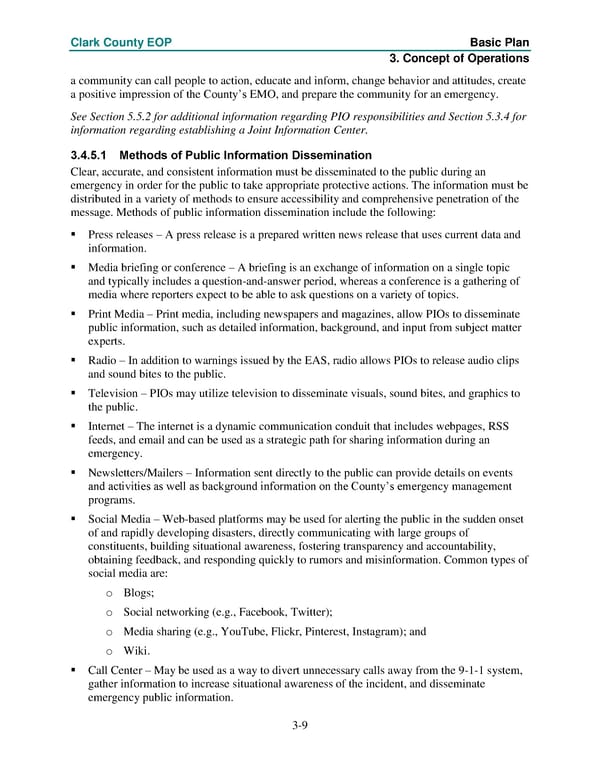Clark County EOP Basic Plan 3. Concept of Operations a community can call people to action, educate and inform, change behavior and attitudes, create a positive impression of the County’s EMO, and prepare the community for an emergency. See Section 5.5.2 for additional information regarding PIO responsibilities and Section 5.3.4 for information regarding establishing a Joint Information Center. 3.4.5.1 Methods of Public Information Dissemination Clear, accurate, and consistent information must be disseminated to the public during an emergency in order for the public to take appropriate protective actions. The information must be distributed in a variety of methods to ensure accessibility and comprehensive penetration of the message. Methods of public information dissemination include the following: Press releases – A press release is a prepared written news release that uses current data and information. Media briefing or conference – A briefing is an exchange of information on a single topic and typically includes a question-and-answer period, whereas a conference is a gathering of media where reporters expect to be able to ask questions on a variety of topics. Print Media – Print media, including newspapers and magazines, allow PIOs to disseminate public information, such as detailed information, background, and input from subject matter experts. Radio – In addition to warnings issued by the EAS, radio allows PIOs to release audio clips and sound bites to the public. Television – PIOs may utilize television to disseminate visuals, sound bites, and graphics to the public. Internet – The internet is a dynamic communication conduit that includes webpages, RSS feeds, and email and can be used as a strategic path for sharing information during an emergency. Newsletters/Mailers – Information sent directly to the public can provide details on events and activities as well as background information on the County’s emergency management programs. Social Media – Web-based platforms may be used for alerting the public in the sudden onset of and rapidly developing disasters, directly communicating with large groups of constituents, building situational awareness, fostering transparency and accountability, obtaining feedback, and responding quickly to rumors and misinformation. Common types of social media are: o Blogs; o Social networking (e.g., Facebook, Twitter); o Media sharing (e.g., YouTube, Flickr, Pinterest, Instagram); and o Wiki. Call Center – May be used as a way to divert unnecessary calls away from the 9-1-1 system, gather information to increase situational awareness of the incident, and disseminate emergency public information. 3-9
 Emergency Operations Plan Page 51 Page 53
Emergency Operations Plan Page 51 Page 53